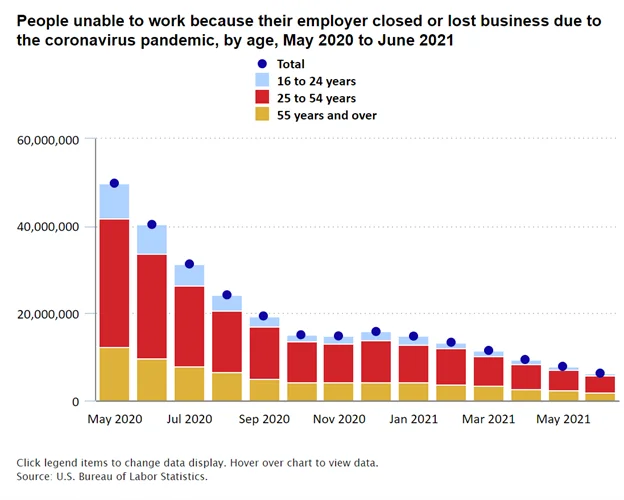Business Continuity and Disaster Recovery (BCDR): The Cornerstone of Resilience, Empowered by Workflow Automation Software
In this swift and unpredictable world, the disruptions are inevitable. This may be caused by cyber-attacks, natural disasters, hardware failures, or even human error that disrupt any company as harshly as it indeed disrupts operations, reputation, and eventually the bottom line. This recent pandemic, which took the world by surprise, proved how much of an impact a crisis could have on business.
The core of successful BCDR strategies would be adopting Workflow Automation Software to synergize the vital processes, reduce the time of downtime, and thus make recovery faster.
“In June 2021, of the 6.2 million people in the US alone that did not work at all or worked fewer hours at some point in the last 4 weeks because their employer closed or lost business due to the coronavirus pandemic” [1]

“About 25 percent of businesses do not reopen after disasters.” In times of uncertainty and crisis, Business Continuity and Disaster Recovery (BCDR) emerge as the essential safety net, providing businesses with the resilience and adaptability needed to weather the storm and emerge stronger. Organizations leveraging Business Process Automation gain a competitive edge by mitigating risks associated with manual interventions. In this blog, we’ll discuss the necessity of BCDR from a business standpoint, especially in light of the pandemic’s lessons, and how workflow automation software can be a vital component of a strong continuity plan.

The Significance of BCDR from Businesses Perspective
1. Ensuring Uninterrupted Operations
The BCDR planning that an organization does, enables it to do what is essential by keeping it running during or after a disruption event. The BCDR plans are conceptualizations in business continuity and disaster recovery that help keep businesses in business, allowing predetermined processes, systems, and services to operate even amidst adversity. This translates to minimal downtime and reduced financial losses during disruptions, instilling confidence in stakeholders and customers alike. ”From 2019 through 2022, 96% of organizations experienced at least one incidence of downtime”. “For more than 90% of mid-sized and large enterprises, the cost of downtime exceeds $300,000 an hour”[2]
2. Mitigating Risks and Protecting Data
Disasters can strike without warning, putting businesses at risk of losing valuable data and assets. “83% of organizations have experienced multiple data breaches” as per IBM [3]. BCDR strategies involve robust data backup, replication, and secure storage, mitigating the risk of data loss. Additionally, it provides a framework to identify potential risks and vulnerabilities, enabling proactive measures to minimize their impact.
3. Meeting Regulatory and Compliance Requirements
For organizations working in regulated settings, meeting standards set by the industry and statutory requirements is compulsory. The BCDR plan as a whole will show an investment made by the company for safeguarding vital assets along with their customers. Most provisions are also accepted as provisions in organizational compliance, thus helping in meeting customer trust.
Leveraging Workflow Automation Software for BCDR
1. Streamlining BCDR Processes
Because it facilitates the execution of continuity strategies, workflow automation software has the potential to revolutionize BCDR. Businesses may respond quickly to interruptions, cutting down on recovery time and human error, by automating a variety of operations, including data backup, system monitoring, and incident response. Businesses of all sizes are increasingly choosing cloud-enabled data backup and recovery solutions. As per Unitrends 2019 survey, “84 percent of all businesses store data or backups in the cloud.”
2. Enhancing Disaster Recovery Efficiency
In the face of calamity, every second counts, and workflow automation software would rather orchestrate the recovery process by automating failover and failback procedures and allowing teams to work together. As an example, this enables the resumption of business activities with the least possible interruption.
3. Real-time Monitoring and Alerts
Workflow automation software can monitor vital applications and systems in real-time, quickly identifying irregularities or malfunctions. It can send out automated notifications to the appropriate teams, allowing them to act right away and reduce possible hazards before they become serious problems.
4. Improving Documentation and Compliance
To guarantee their efficacy, BCDR programs need thorough documentation and recurring testing. The complete BCDR process can be documented with the help of workflow automation software, which will make it simpler to maintain and update. Additionally, it may automate the auditing and testing of BCDR strategies, guaranteeing adherence to legal mandates.
Optimizing Workflow Automation with Cloud Deployment
1. Cloud-Powered Scalability
Workflow automation software in the cloud benefits from its inherent scalability. As businesses grow, their automation needs may expand exponentially. Cloud deployment allows seamless expansion of resources to accommodate increased automation requirements, supporting business growth without disruptions. “Percentage of all organizations that operate 100% cloud-hosted workloads is expected to increase by 70% by 2023”[4]
2. Enhanced Collaboration and Accessibility
Teams can work together in real-time, no matter where they are physically located, when workflow automation software is set up in the cloud. Cloud-based solutions provide safe access to automated processes from any location, encouraging effective teamwork and communication whether on-site or remotely.
3. Automatic Updates and Maintenance
Cloud delivery relieves one from the manual effort of upgrading and maintaining software. Vendors release continuous updates and patches to make the software secure and always up to date, relieving businesses of doing such tasks and allowing them to concentrate on core activities.
4. Disaster-Resilient Automation
By hosting workflow automation software in the cloud provided by cloud providers such as Microsoft Azure, businesses ensure that critical automated processes remain unaffected during disruptions. Cloud service providers maintain high levels of redundancy and fault tolerance, ensuring continuous automation operations even in the event of hardware failures or localized disasters.
From a business standpoint, disaster recovery and business continuity (BCDR) are the cornerstones of growth and resilience, not merely abstract ideas. Long-term performance depends critically on the organization’s capacity to tolerate setbacks, safeguard vital resources, and continue operating without interruption. However, achieving these goals can be challenging without the right tools. This is where Microsoft cloud-based Software as a Service workflow automation solution such as AffableBPM becomes a critical supporting element. By streamlining BCDR processes, enhancing efficiency, and providing real-time insights, workflow automation software such as AffableBPM empowers businesses to navigate through turbulent times with agility and confidence. The integration of Workflow Automation Software into any organization will strengthen the organization’s BCDR frameworks with coherent adaptable processes and methods that are also very effective. It guarantees data integrity and operational consistency. In this sense, adapting AI-enabled SaaS solutions has become a modern strategy for organizations. BCDR with workflow automation software is a future-oriented investment, developing a culture of readiness and responsiveness that will allow businesses to survive in an increasingly unpredictable world.
[1] https://www.bls.gov/opub/ted/2021/6-2-million-unable-to-work-because-employer-closed-or-lost-business-due-to-the-pandemic-june-2021.htm
[2] https://invenioit.com/continuity/disaster-recovery-statistics/



